HULFT Transfer Jobs
On the HULFT Transfer Jobs page in the Main category, you can create jobs that use a HULFT Transfer service.
Jobs link projects and scripts that are created in HULFT Square and various settings information, to manage them as a package.
HULFT Transfer jobs link information such as the execution timing, execution environment, and transfer settings for scripts that are executed after file transfer processing.
When you use the receive function of the HULFT Transfer service, be sure to create a HULFT Transfer job according to the functions and operations that you are using.
The user who creates a job becomes the user who executes the job (script).
Users can specify workspaces in HULFT Transfer jobs to share with other users or groups.
For more details about how to use workspaces to share settings, refer to Share settings with team members.
This section explains some points about the creation and setting of jobs that use the HULFT Transfer service.
Tutorials
For the entire operational flow of HULFT Square, including the creation and setting procedures for jobs, refer to the following tutorial:
What needs to be done before job creation
Because information that is already set is linked to create a job, the following settings need to be complete before job creation.
|
Preparation before job creation |
Settings information for job creation |
Reference |
|
|---|---|---|---|
|
1. |
Setting of the HULFT Transfer service (HULFT Receiver) |
HULFT Transfer service (service name) |
|
|
2. |
Setting of the HULFT Transfer Host configurations |
Host name of the remote host |
|
|
3. |
Setting of the HULFT Transfer Receive configurations |
Identification name of the HULFT Transfer Receive configuration (transfer name) |
|
|
4. |
Setting of the profile |
Information on the profile (profile name) |
Profiles |
|
5. |
Creation of the project, and of the script that is executed after receiving |
Information on the project and script (project name/script name/script variable name) |
|
Check whether the settings above are complete before job creation, and if there are settings that aren't complete, finish the settings.
When you create or update a job, the HULFT Transfer Receive configuration and the HULFT Transfer Host configuration linked to the HULFT Transfer Receive configuration are loaded to the HULFT Transfer service (HULFT Receiver) that you specify for the job.
If you modify the HULFT Transfer Receive configuration or the HULFT Transfer Host configuration linked to the HULFT Transfer Receive configuration, the job must be updated to reload them to the HULFT Transfer service.
Points on job creation and setting
This section explains some points about the creation and setting of jobs on each settings page.
For the names and functions of the basic UI elements and other items of HULFT Square, refer to the following topic:
HULFT Transfer Jobs
To open this page, select  > JOBS > HULFT Transfer Jobs in the navigation menu.
> JOBS > HULFT Transfer Jobs in the navigation menu.
You can create and set up a new job or update information that is already set.
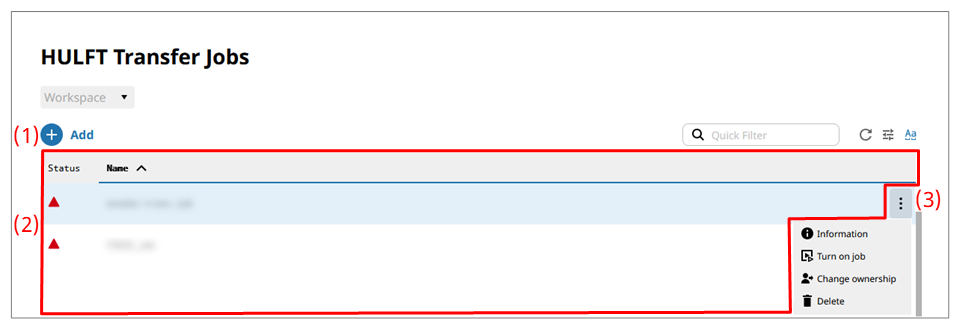
- (1) Add
-
Select this icon to create a new HULFT Transfer job.
For the screen displayed after selecting this icon, refer to HULFT Transfer Jobs > Add New.
- (2) List of settings
-
The information of jobs (HULFT Transfer) that are already created is displayed in tabular form.
The status is indicated as follows:

:
This icon indicates that the HULFT Transfer job is running.

:
This icon indicates that the HULFT Transfer job is stopped.
For details on each field other than the status, refer to the explanation on HULFT Transfer Jobs > Add New.
= Remarks =You can register more than 5,000 HULFT Transfer jobs, but the maximum number displayed for each workspace is 5,000. If you select multiple workspaces, the amount over 5,000 isn't displayed.
- (3) Action menu
-
Select this icon to perform an operation for a job that is already created.
Selecting
 shows the menu of operations below.
shows the menu of operations below.- Information
-
Displays detailed information about the selected HULFT Transfer job. You can also edit and delete the detailed information.
For the screen displayed after selecting this menu item, refer to HULFT Transfer Jobs > HULFT Transfer job name.
- Turn on/off job
-
Turns the selected HULFT Transfer job on and off.
- Change ownership
-
Changes the ownership of the selected HULFT Transfer job to another member. When you change the owner, the value of Author changes.
In order to change the ownership, in addition to permission to view the HULFT Transfer job, you need the permission ChangeOwnership.
- Delete
-
Deletes the selected HULFT Transfer job.
To open this page, select Add on the HULFT Transfer Jobs page.
You can set the information to create a job by following the wizard-style pages step by step.
Step General
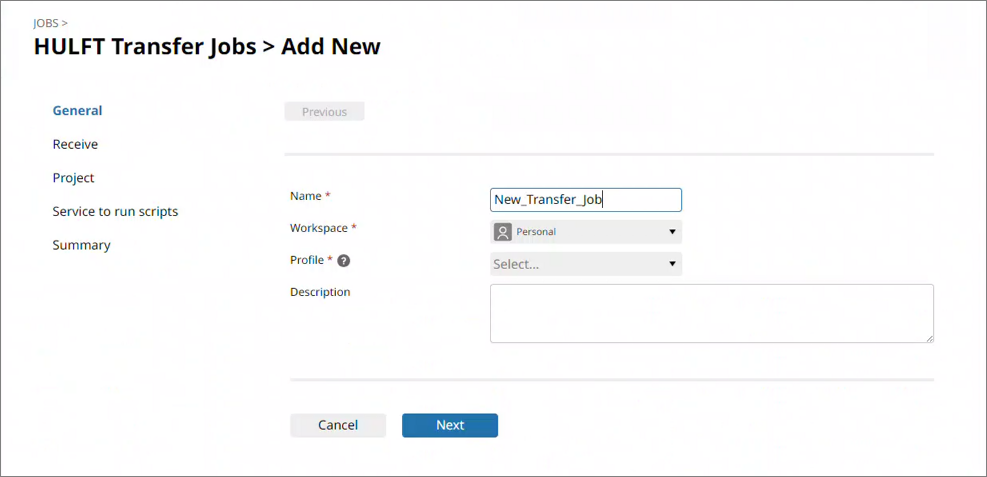
- Name
-
Specify the name of the job that you create.
- Workspace
-
To share the HULFT Transfer job, select the workspace with the users and groups specified that you want to share with.
- Profile
-
Select the profile to load the resources used in the HULFT Transfer job.
- Description
-
Specify comments to explain the job that you create.
- Next
-
Displays the next page.
Step Receive
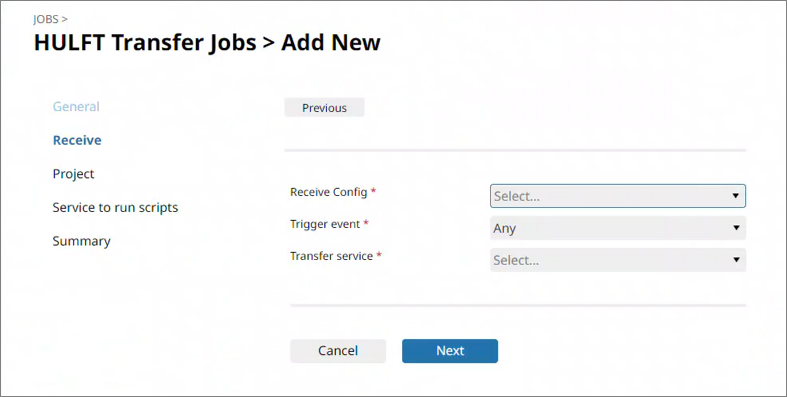
- Receive Config
-
Specify the name of the HULFT Transfer Receive configuration to link with this job.
- Trigger event
-
Select the execution timing of the script that you link with this job.
- Any
-
Regardless of the file transfer result, the script is executed when a file transfer event occurs.
- Succeed in receive
-
The script is executed when the file transfer result is success.
- Fail to receive
-
The script is executed when the file transfer result is failure.
- Transfer service
-
Specify the name of the HULFT Transfer service (HULFT Receiver) that you link with this job.
- Next
-
Displays the next page.
Step Project
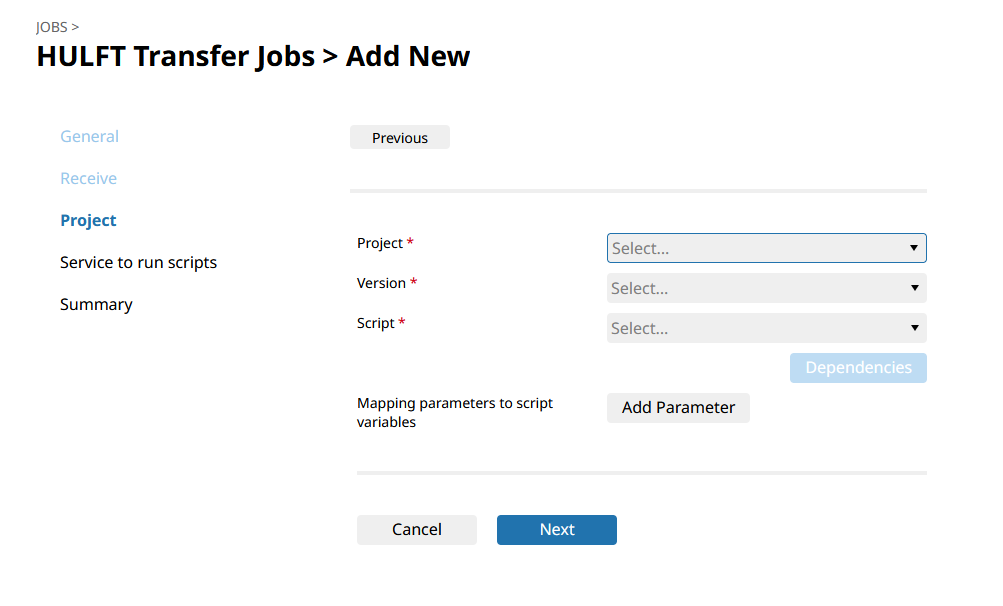
- Project
-
Select the name of the project that manages the script whose execution is linked with the file transfer.
- Version
-
Select the version of the project that you specified.
- Script
-
Select the name of the script whose execution is linked with the file transfer.
After you specify the script, you must set the dependency relationship.
For more details, refer to Script dependency.
- Mapping parameters to script variables
-
You can associate the following parameters with script variables:
- Transfer host
-
Select the script variable that stores the host name of the remote host.
- Transfer name (Receive)
-
Select the script variable that stores the name of the HULFT Transfer Receive configuration.
- File to receive
-
Select the script variable that stores the receive file name as a full path.
- Status code
-
Select the script variable that stores the code for the transfer status that links with the script execution.
- Detail code
-
Select the script variable that stores the detail code for the transfer status that links with the script execution.
- Next
-
Displays the next page.
Step Service to run scripts
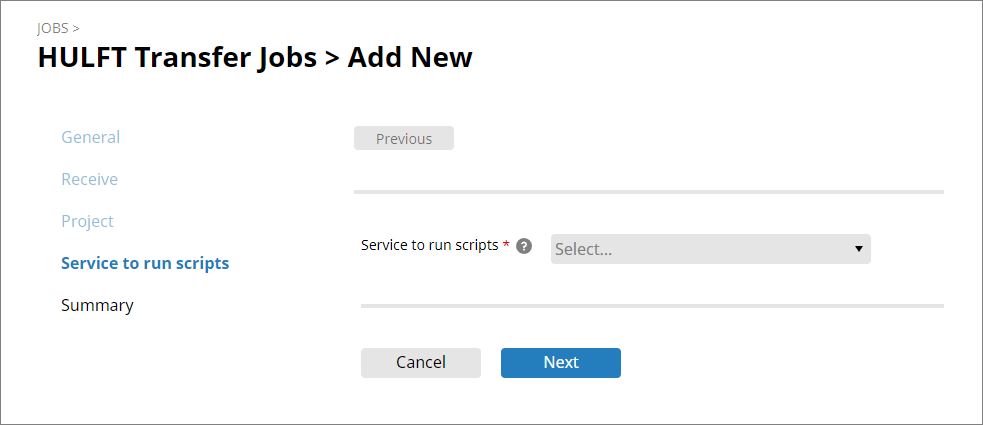
- Service to run scripts
-
Select the HULFT Integrate service to run the specified script.
- Next
-
Displays the next page.
HULFT Transfer Jobs > HULFT Transfer job name
To open this page, select Information from the action menu in the list of settings on the HULFT Transfer Jobs page.
The detailed information of the selected job is displayed. You can edit and delete the detailed information as well as turn the job on and off.